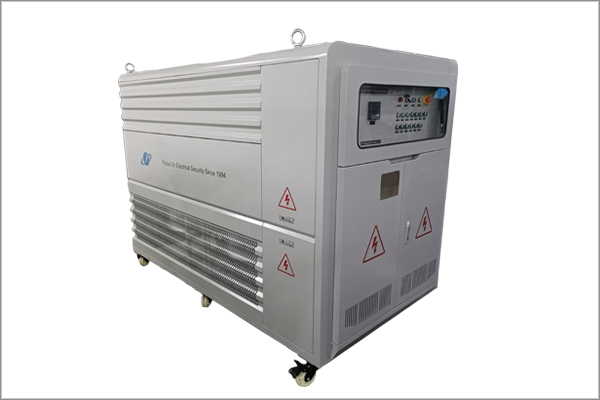What are the primary functions and applications of air-cooling load banks?
Time:2025-05-22
The air-cooling load bank is a device that achieves power loading and testing through air convection heat dissipation. Its core function is to simulate real load conditions and monitor the performance stability of the electrical system. Air-cooling load bank's main functions, uses and typical application scenarios are as follows:
I. Core Functions
1. Power loading and testing
Function description: By simulating the power consumption of actual loads (such as motors, transformers, power supply equipment, etc.) through components like resistors and inductors, it tests the load-carrying capacity, voltage/frequency stability, overload protection and other performance of power generation equipment (such as generators, UPS power supplies, battery packs).
Technical implementation: Built-in cooling fan + heat sink, which removes the heat generated by the resistance heating element through air flow, maintaining the operating temperature of the equipment within a safe range.
2. Energy efficiency and stability monitoring
Function description: Real-time monitoring of parameters such as current, voltage, power factor, and temperature rise, assessment of the energy efficiency level and long-term operational stability of the equipment under test, and early detection of potential faults (such as poor contact and component aging).
Data output: Supports local dashboard display or data upload to the monitoring system through interfaces such as RS485 and Modbus, facilitating remote operation and maintenance.
3. Load regulation and simulation working conditions
Function description: Supports hierarchical loading (such as 10%, 50%, 100% load steps) or continuously adjustable load, simulates the operating state of the equipment under different working conditions (such as light load, full load, overload), and tests its dynamic response capability.
Application value: Helps users verify the reliability of equipment under extreme conditions (such as sudden start-up shock and long-term full-load operation).
Ii. Main Uses and Typical Scenarios
Testing and maintenance of power generation equipment
Purpose:
Factory tests and regular maintenance of diesel/gas generators (such as load trial operation to test output power and fuel consumption efficiency).
Charge and discharge tests of energy storage battery packs for photovoltaic/wind power generation systems to verify the power supply stability in off-grid mode.
Scene case:
Commissioning of power plant generator sets, annual inspection of backup diesel generators in data centers, and acceptance of energy storage systems in new energy power stations.
2. Performance verification of power supply equipment
Purpose:
The load-carrying capacity test of UPS (Uninterruptible Power Supply) ensures stable switching and continuous power supply when the mains power is interrupted.
Load characteristic tests of switching power supplies and inverters, evaluating indicators such as output voltage ripple and dynamic response time.
Scene case:
Annual maintenance of UPS for communication base stations, testing of power modules for electric vehicle charging piles, and power debugging for industrial automation control cabinets.
3. Electrical system commissioning and acceptance
Purpose:
The load-carrying trial operation of newly-built power distribution systems (such as substations and distribution boxes) is conducted to detect the temperature rise of the lines and the sensitivity of the protective devices' actions.
Load testing of mobile power systems such as ships and railways to verify the power supply reliability in complex environments.
Scene case:
Completion acceptance of commercial building power distribution systems, commissioning of ship power stations, and load tests of high-speed rail traction substations.
4. Scientific research and teaching experiments
Purpose:
Teaching demonstrations of power electronics courses in university laboratories (such as Ohm's Law and Joule's law experiments).
Load simulation in the research and development of new power supply technologies in scientific research institutions (such as fuel cell and supercapacitor testing).
Scene case:
The practical training platform for electrical engineering students and the new energy technology research and development laboratory.
5. Emergency and temporary load testing
Purpose:
Load simulation for outdoor temporary power supply scenarios (such as exhibitions and disaster relief) to quickly verify the availability of temporary power sources.
An assessment of the load-carrying capacity of old equipment before its retirement to determine whether it needs to be replaced or upgraded.
Scene case:
Testing of temporary power generation vehicles for outdoor performances and performance inspection of old transformers in factories before retirement. Air-cooled load banks, with their low cost, easy deployment and maintenance-free features, have become the preferred tool for testing power equipment in medium and low power scenarios, and are widely used in the daily maintenance and performance verification of power generation, power supply, distribution and other fields.
News Recommendation
-
 2024-09-11
2024-09-11TRIUMPH LOAD EXHIBITING AT Enlit Europe 2024 -BOOTH 7.H08
-
 2023-04-21
2023-04-21TRIUMPH LOAD EXHIBITING AT DATA CENTER WORLD GERMANY 2023-BOOTH F909
-
 2023-04-06
2023-04-06TRIUMPH LOAD EXHIBITING AT ELECTRIC POWER TECH KOREA 2023 – Booth G109
-
 2022-05-05
2022-05-05What is the role of ac load bank for power supply?
-
 2022-05-05
2022-05-05What is the role of the load bank?


